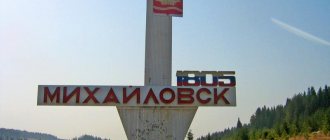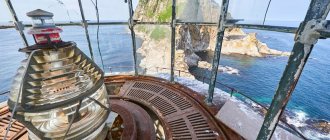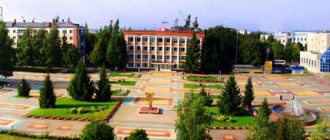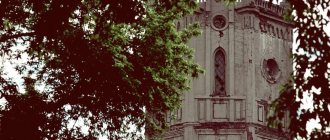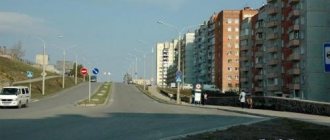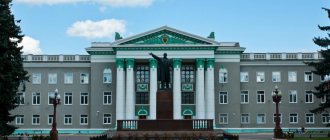About the history of the city of Miass
A settlement in the vicinity of present-day Miass appeared in 1773, when the enterprising merchant Luginin Larion started the construction of a copper smelter in this area.
Due to the outbreak of the Pugachev People's War, the construction of the plant was significantly delayed. But in August 1777 it started working. Gradually, the copper deposits dried up, and in 1798, Luginin’s heirs sold the enterprise to the treasury. By the middle of the 19th century, the maintenance of the plant became unprofitable, and it was closed.
But the workers' freedom remained. This was facilitated by the development of gold deposits. In the nineteenth century, the entire valley of the Miass River became a huge gold mine.
The most “advanced” mine was the Tsarevo-Alexandrovsky (later Leninsky) mine. Tsar Alexander I came here during his travels around the country.
This mine had no equal in the region in terms of the number and wealth of gold nuggets found. In 1842, craftsman Nikifor Syutkin found here one of the largest nuggets in the world - the “Big Triangle”, weighing 36.21 kg.
Egor Mitrofanovich Simonov, who went from an ordinary prospector to the owner of mines and became the richest man in the city, became widely known and had a prominent position in the city.
Gold mining remained the main city-forming industry in Miass until Soviet times. Under the USSR, other industries were created here.
In 1891, from Miass and Vladivostok simultaneously, towards each other, they began to build the Trans-Siberian Railway. This most famous section of the Trans-Siberian Railway “from the Urals to the Pacific Ocean” was built from 1891 to 1916. In 1903, the first train St. Petersburg - Moscow - Vladivostok passed along the Trans-Siberian Railway. From Moscow to Miass by rail it is exactly 2 thousand kilometers.
City center in the old days
This unique role of Miass in the history of our country is recalled by a memorial sign at the Miass-1 station, erected in honor of the 100th anniversary of the start of construction of the Trans-Siberian Railway.
In December 1919, Miass received city status. In 1923, the local city council was going to rename the city Tukhachevsk - in honor of the famous Red commander Mikhail Tukhachevsky, who took the city into civilian rule. But the authorities rejected this initiative.
In the 1930s, along with gold mining, the city began to seriously develop the timber industry, and then mechanical engineering.
At the end of 1941, automobile production was established on the basis of the workshops of the Stalin Automobile Plant in Miass that were evacuated from the capital. First they produced engines and gearboxes, then ZiS-5 trucks. And after the war, they started producing their own models - the famous Ural trucks.
Defense and rocketry design bureaus in Mashgorodok also became important enterprises.
Since the late 1950s, beautiful roads and sidewalks, well-groomed alleys and squares, flower beds, special design of hotel buildings, a swimming pool, cafes and shops, pine and linden alleys have appeared in this microdistrict of the city. A group of architects received a State Prize for this residential area.
Since the 1970s, a large-panel house-building plant has been operating in the city. In addition to the industrial sector, the resort and sanatorium and tourism sectors began to actively develop (resorts on Lake Turgoyak, ski slopes, tours to the most picturesque places of the Southern Urals).
An annual event that has become widely known is the Ilmen Art Song Festival, which takes place in mid-June.
City infrastructure
The utility fee for a two-room apartment with two registered apartments ranges from 3.5 thousand in winter to 1.6 thousand in summer. There are no problems with heating, cold-hot water or electricity. However, we won’t say that everything is rosy and wonderful. For example, in Mashgorodok and the village of Stroiteley, hot water periodically flows of terrible quality, with a disgusting smell of rot.
City authorities explain this by old problems with wastewater treatment plants, but this does not make it any easier for residents, because sometimes they have to take a shower without holding their nose.
Playground
The central roads in the city are quite decent, but it is better to walk around the courtyards rather than drive a car; only an SUV can drive through continuous potholes. But there are no traffic jams at all.
Trolleybuses run from the station along the main street, Avtozavodtsev Avenue. There are only two routes: one of them (No. 4), after passing Avtozavod, turns to the village of Stroiteley, the other (No. 3) goes to Mashgorodok. The main burden of transporting passengers is taken on by minibuses.
At the exit from the railway station
There are enough kindergartens and schools in Miass so that your child can go to kindergarten and school wherever you want. Of course, the best schools admit students on a competitive basis. First of all, this applies to Lyceum No. 6 and Gymnasium No. 4, the most prestigious schools in the city. However, if you are not confident in your child’s strengths or his desire to learn, it is better to choose schools that are more comfortable for a child’s life, where at least the child will have vacations, and not continuous Olympiads, seminars, scientific societies, etc.
Among the secondary specialized educational institutions of the city are a geological exploration college, a pedagogical college, a music college, and several technical colleges. There are two higher educational institutions: branches of the South Ural State University and Chelyabinsk State University, as well as a representative office of the Chelyabinsk Pedagogical University.
There are two local TV channels in Miass, Miass-TV and Ekran-TV, and the city press is represented by two newspapers - “Miasssky Rabochiy” and “Glagol”.
Museum of Local Lore
The Miass Museum of Local Lore is one of the oldest in the Urals. Back in the 19th century, a museum exhibition was set up in one of the rooms of the plant management building. In 1920, the city local history museum was founded in the format of a large cultural institution.
In 1995, the local history museum moved to an old building - the mansion of the wealthy gold miner Simonov, which he had already occupied in the 1920s.
Museum of Local Lore
The exhibition halls of the museum display exhibitions that clearly and interestingly tell about the history of the region since ancient times, about the life of the workers of the Miass plant and their families. The museum collections reflect all aspects of the social and cultural development of Miass and the territories adjacent to this city.
The museum owns not only a remarkable 19th-century building, but also a courtyard and garden. In the summer, this territory becomes an arena for children's master classes, games, quest trips, theatrical and costume events.
Address: st. Pushkina, 8.
UralAZ Museum
The Museum of the Glorious Enterprise has been operating since 1969. It introduces visitors to the history of the Ural Automobile Plant. The museum’s exposition opens with the section “Evacuation from the Moscow Stalin Plant.” The display cases contain authentic documents, things and objects from 1941-1942.
In the “First Products” section, products are displayed, the production of which was associated with the initial period of work; it tells how a working team was formed from employees who came from Moscow and indigenous residents of the Urals.
The section “The first car to the front” tells the story of the transformation of an automobile engine plant into a car plant and the production in 1944 of the first Ural truck, the ZiS-5. The section “Automobile Plant Workers on the Fronts of the Great Patriotic War” is dedicated to the labor and military exploits of the automobile plant workers.
The section “Labor in the post-war period” contains documents, photographs, and models of cars from the period of restoration of the national economy.
UralAZ Museum
The seventh special section of the museum shows how the Oktyabrsky village was transformed into a modern industrial city with all possible infrastructure.
The section “A New Era in the Life of the Plant” tells about the reconstruction of the plant, the creation in the shortest possible time of a new three-axle off-road truck Ural-375D and the development of its production. A separate stand is dedicated to the development of Ural car models and their creators - the designers of the enterprise.
The construction of new production buildings and the creation of new modifications of cars are also reflected. Of course, there is an extensive collection of scale models of cars of various modifications, as well as an exhibition of cups won by the car plant team in international truck trial competitions.
Visitors are offered sightseeing and thematic excursions, watching interesting videos about car testing and truck trial competitions.
Address: Avtozavodtsev Ave., 1.
Bunch-
This is the release of gases from the intestines, which also produces a sound.
Fart facts:
1. On average, one release of gaseous waste products from the intestines contains 59 percent nitrogen; 21 percent hydrogen; 9 percent carbon dioxide; 7 percent methane; 4 percent oxygen. Less than 1 percent are components that create an unpleasant odor. 2. The temperature of the gases at the time of the “shelling” is 98.6 degrees Fahrenheit. 3. The rate of release of gaseous waste products from the intestines is more than three meters per second. 4. A person produces about half a liter of intestinal gases per day. 5. Women fart as much as men. 6. The gas that creates the foul odor is hydrogen sulfide. The more you eat foods containing sulfur (eggs, garlic, onions, beans, cabbage, cheese), the more you “spoil the air.” 7. Most people fart about 14 times a day. 8. People fart even after death. 9. Gas coming out of the anus can actually ignite. 10. Everyone farts: turtles, fish, snakes and other reptiles, as well as dogs and cats. 11. Some environmentalists believe that the release of gaseous waste products from the intestines causes irreparable damage to the environment. In particular, one of the causes of global warming is cow farting, some scientists believe. How to treat such statements is up to you, of course.
As you know, ordinary farting can become a disease called flatulence.
.
FLATULENCE
The accumulation of gases in the stomach or intestines can be isolated, for example after eating a meal that is particularly conducive to the release of gases, but it can also be a permanent, chronic sign of malfunction of the digestive system. In the second case, this may indicate a disease, such as diverticulitis or inflammatory bowel syndrome, and therefore requires contacting a specialist to identify the cause of flatulence.
Causes of flatulence
The causes of flatulence in the intestines are extremely varied. Flatulence can occur in a child already in the first days after birth as a result of imperfection of the enzyme system or disruption of its function. A lack of enzymes leads to the entry of a large amount of undigested food debris into the lower parts of the digestive tract and the activation of rotting and fermentation processes with the release of gases. Disorders of the enzyme system can occur with an unbalanced diet, as well as various diseases of the upper digestive tract (gastritis, duodenitis, pancreatitis, cholecystitis, hepatitis). Another reason for increased gas formation in the intestines is a violation of the microflora of the colon.
Under normal conditions, most of the gases are absorbed by bacteria living in the intestine. When the balance between gas-producing and gas-consuming microorganisms is disturbed, flatulence occurs. Another mechanism for the occurrence of flatulence is intestinal distension as a result of impaired motor activity of the intestine, which develops during various operations on the abdominal cavity. After surgery, intestinal motility is usually impaired. Slowing down the passage of food masses contributes to the intensification of fermentation and putrefactive processes with increased gas formation. Gases accumulating in the lumen of the sedentary intestine cause paroxysmal pain.
The reason for the increase in the amount of gas in the intestine may be food. In addition to legumes and products containing coarse fiber, these include highly carbonated drinks, products that cause fermentation reactions (lamb meat), as well as products in which fermentation and fermentation reactions occur independently (kvass). Nervous disorders and emotional overload can lead to flatulence due to spasm of intestinal smooth muscles and slower peristalsis.
Depending on the cause, the following types of flatulence are distinguished:
- on a diet rich in cellulose and eating beans;
- in case of digestive disorders (gastritis, pancreatitis, cholelithiasis);
- due to excessive bacterial growth in the small intestine and disruption of colon biosis;
- in case of mechanical disturbance of the evacuation function of the intestine (tumors, adhesions);
- due to disorders of intestinal motor function (acute infections, intoxication);
- for general and local circulatory disorders;
- caused by psycho-emotional overload and neuropsychic disorders;
- when raised to a height, when gases expand and pressure in the intestines increases.
Manifestations of flatulence
Flatulence is manifested by bloating or attacks of cramping pain, and may be accompanied by nausea, belching, loss of appetite, constipation or diarrhea.
There are two options for the manifestation of flatulence:
- In some cases, the main manifestation is a significant increase in the abdomen due to bloating of the intestines, while the passage of gases does not occur due to spasm of the colon. The main sensations are discomfort, abdominal distension, pain.
- The second option is characterized by constant rapid release of gases from the intestines, which significantly limits the quality of life and stay in society. In this case, the pain syndrome is slightly expressed, complaints of “rumbling” and “transfusion” in the abdomen predominate.
Extraintestinal symptoms may appear: from the cardiovascular system (burning in the heart, rhythm disturbance, mood disorder, sleep disturbance, general weakness).
Treatment of flatulence
The principle of treating flatulence is to eliminate the cause of increased gas formation. Treatment may include the following steps:
- diet correction;
- treatment of diseases that cause flatulence;
- restoration of motor disorders (by prescribing prokinetics);
- treatment of intestinal biocenosis disorders (biological products);
- removal of accumulated gases from the intestinal lumen.
Organization of a balanced diet for patients includes the exclusion of foods containing coarse fiber (cabbage, sorrel, grapes, gooseberries), legumes and those that cause fermentation reactions (kvass, beer, carbonated water). Recommended are fermented milk products, crumbly porridge (buckwheat, millet), boiled vegetables and fruits (carrots, beets), boiled meat only, wholemeal wheat bread with bran.
Absorbing agents are used in the treatment of flatulence: activated carbon (effective only in large doses), white clay, polyphepane, dimethicone, polysorb. They reduce the absorption of gases, toxins and other compounds, and also promote their elimination.
For flatulence, some herbal remedies have a carminative effect: infusions of caraway fruits, coriander, dill, fennel, chamomile flowers, mint leaves.
With absolute or relative insufficiency of the secretion of digestive enzymes, the digestion of the main ingredients of food is disrupted. The following are used as replacement therapy for insufficiency of the gastric and intestinal glands and pancreas: pepsin, pancreatin, natural gastric juice, as well as a number of combined drugs.
AROMATHERAPY
Many essential oils have a carminative effect, that is, they help remove gases from the organs of the digestive system (up or down, depending on where they accumulate) and, therefore, provide relief from bloating and cramps, which may disappear along with the gases. However, it is better to use directly the herbs from which these essential oils are extracted. Oils such as caraway, chamomile, fennel, marjoram and peppermint can also be used when applying warm compresses to the abdomen; It is recommended to add up to 5 drops to a small bowl of warm water.
HERBAL TREATMENT
There are several types of herbal tea that are great for helping with flatulence, but only drink them if excess gas is your biggest problem and requires professional herbal treatment. If gas occurs in the stomach, you can drink catnip tea (Nepeta cataria)
, chamomile
(Chamomilla recutita
), lemon balm
(Melissa officinalis)
or peppermint
(Menthapiperita),
if the small intestine is clearly affected, then to any of the mentioned herbs it is good to add fragrant dill, or garden dill
(Anethum graveokns)
, or fennel
(Foeniculum vulgare) .
For flatulence of the large intestine, ginger
(Zmgiber officinalis)
and peppermint
(Mentha piprnta) are useful.
Depending on the symptoms, you can use some other herbs.
Before you start treating flatulence, it is useful to think about food. Many people are used to eating very quickly, having difficulty breaking away from their work. This leads to swallowing air along with food; This can cause inappropriate digestive enzymes to be produced and food may ferment in the intestines instead of being properly digested. And this leads to the production of excess gases and worsening flatulence. You should try not to be in a bent position for a long time and not to sit curled up on a low sofa immediately after eating - this contributes to the formation of gas, bloating and colic.
HOMEOPATHY
Several remedies that appear in all treatment approaches in this section are also useful in homeopathic treatment. We must first try to find out the cause of flatulence and, depending on it, choose a medicine. First, you should choose a remedy from the following set: Chamomilla, Carboveg, Mihuogssa, or Pulsatilla
, if flatulence is caused by too nutritious or too rich food.
NATUROPATHY
Often the cause of flatulence is a mixture of foods that is too difficult to digest. We need to consider whether it is possible to reduce the fat content of the diet and limit the combinations of proteins and carbohydrates that are eaten. If you find this helpful, you may want to take a closer look at Dr. Hay's nutritional system. Another cause of flatulence may be the use of antibiotics, since this leads to the death of intestinal bacteria. Eating yogurt promotes their reproduction; For the same purpose, you can take concentrated nutritional supplements, for example acidophilus
- in tablets or powders. For the overall health of the body, it is often recommended to eat raw foods rich in coarse fiber; such a diet in itself can lead to increased formation of gases, especially if you switch to it abruptly, right away. The increase in the number of bacteria required to process coarse fibers contributes to the formation of large amounts of gases. So some flatulence in this case is quite natural, although it makes communication with people difficult. To make it easier to solve this problem, it is advised to change your diet gradually.
Flatulence is bloating associated with the accumulation of gases in the intestines. It can occur in various diseases and conditions, the main ones are listed below:
- Dysbacteriosis
- Chronic colitis
- Chronic constipation
- Acute intestinal infections
- Intolerance to certain foods
- Excess fiber in the diet
Food intolerance is associated with a lack of enzymes that are necessary to digest certain chemical compounds contained in food. Thus, to digest milk sugar (lactose), an enzyme called lactase is required. In lactase deficiency, lactose is not broken down and absorbed. At the same time, it is used for their vital functions by bacteria living in the intestines.
Thanks to them, lactose is broken down and a large amount of gas is formed. Intolerance to other types of sugar occurs, but the mechanism is the same for everyone.
Excess fiber, also with the help of intestinal bacteria, can cause the accumulation of gases in the intestines.
Traditional medicine recipes used for flatulence:
1. The root bark, barberry root in the form of a decoction is taken orally for chronic diseases of the liver and gall bladder, flatulence, etc. Decoction: 2 teaspoons of the raw material are boiled for 5 minutes in 2 tbsp. water, leave for 2 hours and drink 1/2 cup of warm infusion 3-4 times a day before meals. 2. Flaxgrass herb in the form of an infusion is taken orally as a gentle laxative for habitual constipation and flatulence. Infusion: 1-2 tbsp. spoons of herbs are infused for 2 hours in a glass of boiling water and taken 1-2 tbsp. spoons of infusion 3-5 times a day and 1/4 cup at night. 3. Chamomile inflorescences in the form of an infusion are taken orally for inflammatory diseases of the gastrointestinal tract (gastritis, colitis and enterocolitis), flatulence and other ailments. Infusion: 2 tbsp. spoons of warm infusion 3-4 times a day for 2-3 months. 4. The fruits and herbs of dill liver as a remedy in the form of an infusion are taken orally to improve digestion, for chronic colitis, constipation, flatulence and abdominal cramps. Infusion: 1 tbsp. a spoonful of crushed fruits or herbs is infused for 2 hours in 2 tbsp. boiling water and drink 1/2 cup of warm infusion 3 times a day before meals. 5. The herb (night blindness) in the form of an infusion is taken orally for liver diseases, in particular liver enlargement, chronic constipation and flatulence. Infusion: 2 tbsp. spoons of herbs are infused for an hour in 0.5 liters of boiling water and drunk 1/2 cup of warm infusion 3-4 times a day before meals. 6. The fruits of caraway seeds in the form of powder or infusion are taken orally as a tonic for the intestines, relieving the processes of rotting and fermentation in the intestines, atony and pain in it, atonic constipation and flatulence. Powder from the fruit is taken 2-3 g 3-4 times a day an hour before meals, washed down with warm boiled water. Infusion: 1-2 teaspoons of crushed fruits are infused for 2 hours in a glass of boiling water and 1/4 cup of infusion is taken 3-4 times a day an hour before meals. Children – a teaspoon (can be mixed with honey to taste) 5-6 times a day. 7. Wormwood herbs - 10 g, yarrow herbs - 20 g, horsetail shoots - 20 g. Infusion: tbsp. a spoonful of the collection is infused for 1-2 hours in a glass of boiling water and drunk 1/2-2/3 glass of warm infusion 3-4 times a day before meals for flatulence and a tendency to diarrhea. 8. Coal from the branches of black poplar (sedge) or linden is ground into powder and taken orally 1/2-1 teaspoon 3-4 times a day, washed down with warm boiled water, before meals for flatulence and cramps in the gastrointestinal tract, especially of nervous origin. 9. Centaury herbs, tansy inflorescences, caraway inflorescences - equally. Infusion: Art. a spoonful of the collection is infused for 1-2 hours in a glass of boiling water and drunk 1/2-2/3 glass of warm infusion 3-4 times a day before meals for flatulence and a tendency to diarrhea. 10. Oat cereals – 1 tbsp. spoon, cumin fruit - 2 tbsp. spoons, yarrow leaves - 2.5 tbsp. spoons, dill fruits - 1 teaspoon Infusion: the whole collection is infused for 1-2 hours in 2 tbsp. boiling water and take 2-3 tbsp. spoons of infusion every 2 hours for flatulence in adults.
infomix.ru - Online store. 11 facts about farting.
ru.wiktionary.org - information from Wiktionary, a multilingual open dictionary.
meteorismos.aptekaonline.ru - information from the website 101 diseases. Section Flatulence.
akviloncenter.ru - website "Esoteric Flatulence. Treatment of flatulence with folk remedies"
lechebnik.info - site Medical Library. Encyclopedia of self-medication. Section "Flatulence".
diagnos.ru - Diagnoz.RU. All about flatulence.
Museum of the Ilmen State Mineralogical Reserve
This museum has existed since 1925. In 1936, the first wooden museum building with an area of 300 square meters was built specifically to house its collections. m, which housed 2 departments: geological and zoological.
The modern museum building has been welcoming visitors since 1990. The area of its exhibition halls is 4500 square meters. m.
Museum of the Ilmen State Mineralogical Reserve
Most of the exhibits characterize the mineral diversity of the Ilmen Mountains. All collections are carefully grouped by field and presented in a very interesting way.
The Biological Hall presents the flora and fauna of the Ilmensky Nature Reserve and the South of the Urals. The central part of the hall is occupied by the “Seasons” diorama, 33 m long, viewing which, visitors on an imaginary journey cross the Ilmensky ridge from west to east, changing different seasons of the year. Small dioramas and showcases show the entire diversity of flora and fauna of the natural zones of the Chelyabinsk region.
Address: Ilmensky Reserve, 1.
Church of the Exaltation of the Holy Cross (Syrostan)[edit]
The Church of the Exaltation of the Holy Cross was built in 1886 according to the exemplary design of K. A. Ton. The quadrangle is crowned with an onion dome, with a small refectory and a tent-roofed bell tower. Closed no later than the 1930s, returned to believers in 1991.
The temple was revived based on drawings and drawings found in the archive. It took the builders 6 years to recreate the original appearance of the temple. Miass artist A. Avseev painted the walls with frescoes. The first service in the restored Syrostan temple took place in 1997.
In November 2013, the domes of the Church of the Exaltation of the Holy Cross were replaced: the main eight-ton dome and the small dome on the bell tower. Thanks to this, the height of the bell tower increased by several meters relative to the previous structure.
Address:
Chelyabinsk region, Miass, village. Syrostan, st. Nagornaya, 3a.
Dumpling Museum
The city’s museum is not only interesting, but also delicious, which tells adults and children about the history of the traditional Siberian delicacy, invites them to take part in master classes on making dumplings and, of course, tastings.
The museum exposition tells about forty different types of dishes, which we are accustomed to consider as originally Russian, but which also exist in the culinary traditions of other countries. The exhibition presents models of dumplings from different countries, each of which has its own shape and manufacturing secret.
Dumpling Museum
The museum has existed since 2014, when the empty and decaying ancient building was purchased by a private individual and restored. At the same time, the facade was preserved in its original form.
In the restored house of merchant Smirnov, in addition to the dumpling museum, there is also a family leisure center, craft workshops, a children's theater, a cafe and a sports complex.
Address: st. Proletarskaya, 5, “House of Merchant Smirnov.”
Train Station
The Miass-1 railway station is a first-class station in the Zlatoust region of the South Ural Railway. Station type: passenger and freight. The railway station is located at st. Academician Pavlova, 42A. The railway station is open every day around the clock. The break in the operation of ticket offices is 30 minutes.
Long-distance trains pass through the railway station in the following directions: Moscow, Chelyabinsk, Tyumen, Novosibirsk, Adler.
Also in the city there is a third-class freight railway station of the Zlatoust region of the South Ural Railway Miass-2.
State Missile Museum
The Museum of the History of the State Missile Center named after Academician Makeev was organized in the 90s, and people began to talk openly about the missile center as one of the enterprises of the country’s defense complex.
State Missile Museum
It is located, among other things, on the premises of the former office of the first general designer, Academician Makeev, which in itself is very valuable. In three exhibition halls, models of various rockets are displayed, clearly demonstrating the rich history of the GRC.
Address: Turgoyak highway, 1.
Memorial "Grieving Mother"
The memorial sculptural group, installed in memory of those killed on the fronts of the Great Patriotic War, was installed on November 4, 1967 on the main square of Miass, next to the administration building.
The square is framed by a semicircular wall of 150 marble slabs, with the names of fellow countrymen who died in the war engraved on them. In the center there is a stele with an outline of a warrior carved on stone, a sculpture of the Sorrowful Mother and the Eternal Flame.
Memorial "Grieving Mother"
Over the years, to the plates with the names of those killed in the Great Patriotic War, the names of those killed in Afghanistan, then in Chechnya, were also added. A monument to the victims of political repression, a monument to the dead border guards, and to all the soldiers of the city who died in the line of duty, wherever.
Address: Central Square.
Church of the Icon of the Mother of God “It is Worthy to Eat” (Miass)[edit]
The construction of the temple in Mashgorodok began back in 2013; before that, negotiations lasted 6 years. It took a lot of time to choose a place. There were four options, and in the end the construction site was located next to the Zarya sports complex.
The church operates a Sunday school for children and catechism courses for adults.
The temple oversees the activities of Orthodox youth associations, and social service is being developed at the parish.
Address:
Chelyabinsk region, Miass, Makeev Avenue, 36-b.
Directions:
from Miass to Mashgorodok by bus No. 3, trolleybus No. 3 and minibuses No. 3, 5, 9, 31, 63 to the “Stadium” stop.
Park of giant stationery figures "Bureaucrat"
Thanks to these extraordinary art objects, Miass was included in the Guinness Book of Records. After all, only here you can see such office supplies: a huge two-meter button, a 2.5-meter high ruler, a nine-meter paper clip, four-meter scissors.
Park of giant stationery figures "Bureaucrat"
On the information stands located nearby, you can read the interesting history of each stationery item.
Address: Oktyabrya Ave., 7.
IN AND. Lenin is an honorary whipper
The monument to the leader of the revolution, the founder of the USSR was laid on the territory of the Miass sawmill on January 27, 1924 - the day of the official farewell to Lenin.
IN AND. Lenin is an honorary whipper
This is due to the fact that on May 1, 1923, at a general meeting of workers, the chairman of the trade union committee proposed making Lenin an honorary member of the factory team. Until the collapse of the USSR (1991), Ilyich was officially listed in the plant’s staff as a 3rd category worker: he was a member of the trade union, he received a salary that went towards organizing cultural events, for children’s recreation, and during the war years - for the needs of the Red Army. Childlessness tax was deducted from “Lenin’s salary” and trade union dues were paid. The plant was equipped with a “Leninist workplace”, where it was considered an honor to work.
Address: st. Proletarskaya, 1.
Crime
Miass is considered by many to be a very criminal city, a city ruled not by the law, but by authorities. However, this is not obvious to the average person. You can safely walk the streets at night, you can let your children play in the yard.
The most resonant criminal event in recent years was the pogrom at the Tornado rock festival in 2010. According to the event organizers, festival participants were attacked by up to 100 men armed with batons and traumatic pistols. According to various sources, from ten to 30 people were injured. Thirteen people were charged. Three of them are accused of organizing mass riots, as well as committing actions aimed at inciting hatred or enmity, using violence, organized by a group. Ten people are accused of participating in mass riots. Despite the widespread dissemination of information about this on the Internet, there was no particular resonance within the city.
Monument to those killed during the Civil War
This memorial was erected in 1957 at a mass grave where Red Guards who died in the battles for the liberation of the city from Kolchak were buried, as well as Soviet activists shot during the White Terror.
Monument to those killed during the Civil War
The monument stands on a square concrete platform and is approached by a wide flight of stairs. On three sides of the stele there are marble memorial slabs with the names of the 97 victims.
Address: Southern District of Miass, Revolution Square.
Memorial “To the Victorious People! To the Creator People!
This sculptural and architectural composition, installed in 1985, consists of a concave parabolic wall lined with concrete slabs. In front of the wall, full-length sculptural compositions are installed on low stylobates. On the left side is a worker with a banner in his hand. Next to him is a bugler.
Memorial “To the Victorious People! To the Creator People!
On the right side is an astronaut raising his hand in greeting, to his left is a girl holding a laurel branch above her head. In the center are a worker and a girl handing a sword to a soldier. These figures are made of decorative concrete. Between them is an inscription in voluminous steel letters: “To the people – the Winner, to the people – the Creator.”
Address: st. Molodezhnaya, Memory Square, behind the Prometheus Palace of Culture.
Monument to the First Ural Automobile
Not far from the UralAZ plant, a memorial complex dedicated to the products of this plant was built. In the center of a large area, in front of a high stele, and on a pedestal, there is a ZiS-5 car, from which the history of UralAZ began in the menacing 40s.
Monument to the First Ural Automobile
Along the perimeter of the site there are steles in a semicircle with images of different models of trucks produced at the Miass UralAZ plant throughout its history. They are installed in chronological order.
Address: Predzavodskaya Square.
Churches and temples of Miass
Church of the Epiphany , on the street. Kolesova, 21, is a new church, the construction of which took 18 years and was completed in 2012.
Church of the Holy Trinity , on Oktyabrya Avenue, 3, is the only ancient temple in the city of Miass that has survived to this day. It was opened back in 1889. During the Soviet period, the church was preserved because it was a cemetery, and the dead were buried there. From 1936 to 1944 the temple was closed, but they did not destroy it.
Church of the Holy Trinity
Church of the Annunciation of the Blessed Virgin Mary , on the street. Gottwald 37a is a new temple built between 2007 and 2017. The church is located in one of the most picturesque places in the city, on the banks of the Miass River.
The Church of St. Michael the Archangel in the village of Turgoyak was built in the 2000s, on the site of an old church that had existed since 1885. It was closed in 1930, turned into a warehouse, and in 1934 it was destroyed.
Later, on the site of the temple, the Luch cinema was built, which operated until the early 2000s. When the question of reviving the temple arose, they tried to recreate it in the cinema building. But it was eventually declared unsafe, so it was demolished, and a new beautiful church was built from scratch. Address: st. Comintern, 39, Turgoyak village.
Intercession Church of the Russian Orthodox Old Believer Church
Intercession Church of the Russian Orthodox Old Believer Church on the street. Malysheva, 38.
The Old Believer community existed in Miass from the very foundation of the city. In 1895, when the government made some relaxations in the legislation in relation to the Old Believers, the city residents built a stone church, but without a cross at the top. In 1936, it was taken from the believers and adapted for a printing house, and then dismantled. Services were held in a prayer house on Berezovskaya Street. The current temple was built in 1995-1999.
Population of Miass
According to statistics at the beginning of 2014, Miass has a population of more than 150 thousand people: Russians, Bashkirs, Tatars, Kazakhs. The population is slowly decreasing (in 2001 there were 165 thousand people), although, starting in 2005, the birth rate began to increase again. But until now there are about two thousand more pensioners than residents under the age of 16, slightly fewer people are born than die, and slightly more people leave the city than arrive.
The level of education and intelligence in Miass is higher than in neighboring Chebarkul, Zlatoust, and Troitsk.
Miass city pond
The city pond is an artificial reservoir located within the city limits and made back in 1776. It was originally created to provide water to a copper smelter. In 1798, a gold mining factory began operating on its dam, which operated for more than two hundred years.
Miass city pond
Nowadays the city pond is simply a beautiful place for cultural recreation for citizens. It's nice to take a walk there with the whole family, enjoying the picturesque views.
Church of the Icon of the Mother of God “Softening Evil Hearts” (Upper Atlan)[edit]
In the village of Verkhniy Atlyan, on January 9, 2016, the ceremonial laying of the temple in honor of the Seven Shot Icon of the Mother of God - “Softening of Evil Hearts” took place.
The temple will be two-story. The lower chapel will be consecrated in honor of St. Sebastian of Karagadin. The basement of the building is already ready.
Construction of the temple began in 2015. On the site of the burned house, relatives of the victims of the fire, on their own initiative, laid the foundation for the building of a future church.
Address:
Chelyabinsk region, Miass urban district, village. Verkhniy Atlyan, st. Central, 18.
Lake Turgoyak
This is a real natural monument and vacation spot. The purity of the water from this lake can be compared with that of Baikal. Picturesque mountain slopes, clean springs, and crystal air attract tourists here at any time of the year.
There are a dozen islands on the lake. One of them is the island of Vera, on which traces of ancient people were discovered: tombs, dolmens, menhirs.
Lake Turgoyak
Along the banks of Turgoyak there are comfortable beaches and recreation centers. You can go boating and explore the bottom of the lake with scuba gear.
Address: Turgoyak village.
How to get to Miass
By car from Chelyabinsk or Ufa, take the M5 highway, then turn at the sign for Miass. From Yekaterinburg go to Chelyabinsk, turn to Kasli, go through Kasli, Kyshtym, Karabash to Miass. Distance from Chelyabinsk - 100 km, from Ekaterinburg - 240 km, from Ufa - 330 km.
Easy to reach by public transport. Buses from Yekaterinburg, Chelyabinsk and other cities go to Miass, and electric trains and passenger trains also pass through Miass.
When visiting Miass, you should definitely visit the nearby Lake Turgoyak, famous for its beauty and purity. It’s not for nothing that they call it Baikal’s younger brother. You can also get to the Ustinovsky canyon, Chashkovsky ridge, Aleksandrovskaya Sopka. Among the event tourism objects, one cannot fail to note the Ilmensky Art Song Festival, which takes place in June in the outskirts of the city - the largest and most famous in the Urals.
References:
Vicky MiassDobreitsina, L.E., Sannikova T.O. Historical cities of the Urals. Part 2. Historical cities of the Southern Urals: Republic of Bashkortostan, Chelyabinsk and Orenburg regions. – Yekaterinburg, 2013. Miass – Wikipedia Miass – 2GIS Miass. Encyclopedic Dictionary of Deep Traditions
Pavel Raspopov
UraloVed.ru
See also:
- Village of Syrostan
- Miass gold placers and the discovery of the Great Triangle nugget (1843)
- Lake Turgoyak and Vera Island (video)
